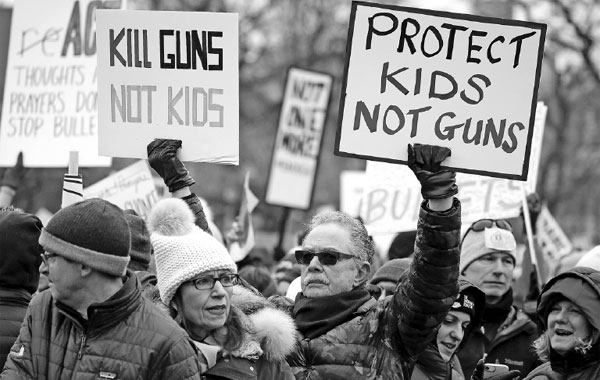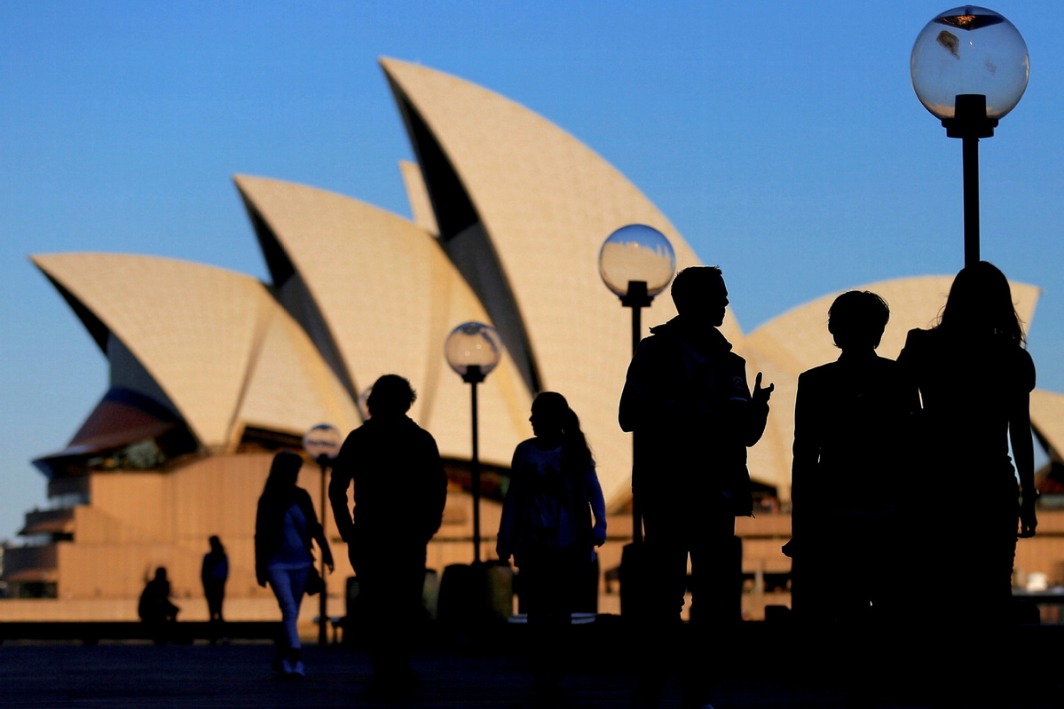Human Rights Record of the United States in 2017


Editor's note: The State Council Information Office of the People's Republic of China on Tuesday published a document titled "Human Rights Record of the United States in 2017".
Following is the full text:
Foreword
On April 20 local time, the State Department of the United States released its country reports on human rights practices for 2017, posing once again as "the guardian of human rights" and a self-styled "human rights judge." It continued to point fingers and cast groundless blame on the domestic affairs and human rights situation of other countries as if it had the most perfect human rights condition in the world. However, looking back on the year of 2017, even those with the slightest sense of righteousness will find that the human rights record of the United States itself remained tarnished and showed a continued tendency to deteriorate.
On the evening of October 1, 2017, almost 60 people were killed and over 800 injured in a mass shooting in Las Vegas, the deadliest mass shooting in modern U.S. history.
In August 2017, some white supremacists rallied in Charlottesville, chanting Nazi slogans in the "largest hate gathering in decades".
According to reports on The Atlantic website and New York Times website, several polls of American scholars revealed that most of the respondents believed that the quality of democracy in the United States had been plateauing for decades, and that American democracy is drowning in money.
Research by Martin Gilens, a politics professor at Princeton University, showed that American economic policies over the last 40 years "strongly reflect the preferences of the most affluent, but bear virtually no relationship to the preferences of poor or middle-income Americans."
A study from the U.S. National Registry of Exonerations released on March 7, 2017 showed that black Americans are about seven times more likely to be wrongfully convicted of murder than white Americans. When it comes to drug crimes, black Americans are about 12 times more likely to be wrongfully convicted than white people. Black male offenders received sentences on average 19.1 percent longer than those of "similarly situated" white male offenders.
The Economic Policy Institute released a report on February 13, 2017, saying that the average wealth for white families is seven times higher than average wealth for black families and that median white wealth is 12 times higher than median black wealth. More than 1 in 4 black households had zero or negative net worth.
According to the websites of The Guardian and the Office of the United Nations High Commissioner for Human Rights in December 2017, 52.3 million Americans lived in "economically distressed communities" and 18.5 million were living in deep poverty.
A BBC report on December 11, 2017 said that of those living in poverty in the United States, there were about 13.3 million children - 18 percent of those under the age of 18. The U.S. Urban Institute statistics revealed that nearly 9 million children in the United States (11.8 percent of American children) would grow up in persistently poor families.
I. Serious Infringement on Civil Rights
Violent crime was on the rise in the United States, the government exercised no effective control over guns which caused continuous growth of gun incidents, power abuse by American police sparked mass protests, and government surveillance infringed individual privacy. As a result, civil rights of the American people, especially the right to life and freedom, were seriously threatened.
Violent crime was on the rise in the United States. According to the FBI's annual report on national crime statistics released in September 2017, there were an estimated 1.2 million violent crimes in the United States in 2016, an increase of 4.1 percent from 2015. It showed the estimated rate of violent crime was 386.3 offenses per 100,000 inhabitants, up 3.4 percent compared with the 2015 rate. The estimated number of aggravated assaults, murders and rapes in the nation in 2016 increased 5.1 percent, 8.6 percent and 4.9 percent, respectively, when compared with the 2015 estimate (www.fbi.gov, ucr.fbi.gov, September 2017).
Ineffective gun control has caused continuous growth of gun violence in the United States. A Pew Research Center survey showed that at least two-thirds of the surveyed Americans had lived in a household with a gun at some point in their lives (www.pewsocialtrends.org, June 22, 2017). Seventy-three percent of the homicides for which the FBI received weapons data in 2016 involved the use of firearms, according to the FBI's annual report on national crime statistics released in September 2017 (www.ucr.fbi.gov, September 2017). According to the Gun Violence Archive of 2017, as of December 25, the total number of incidents in the United States was 60,091, which killed 15,182 and injured 30,619. Among the incidents, 338 were mass shooting (www.gunviolencearchive.org, December 25, 2017). On October 1, 2017, a gunman, named as 64-year-old Nevada resident Stephen Paddock, opened fire from the 32nd floor of the Mandalay Bay Hotel in Las Vegas towards an open-air music festival attended by 22,000. Nearly 60 people were killed and about 500 injured in the mass shooting, the deadliest in modern U.S. history (www.bbc.com, October 2, 2017). The police found 42 guns, thousands of bullets, and explosives in Paddock's hotel room and his home. On November 5, 2017, at least 26 were dead and 20 were injured after a man dressed in black entered First Baptist Church in Sutherland Springs, Texas armed with a rifle and opened fire on its congregation. Those shot ranged from 5 to 72 years old.
U.S. police abused their law enforcement power. According to statistics released by the FBI, law enforcement made an estimated 10,662,252 arrests nationwide in 2016. (Note: the UCR Program does not collect data on citations for traffic violations.) The arrest rate for the United States in 2016 was 3,298.5 arrests per 100,000 inhabitants (ucr.fbi.gov, September 2017). According to The Washington Post's Fatal Force database, 987 people were shot by police in 2017. The Washington Post reported on July 26, 2017, that American police shot and killed a man while trying to serve a warrant at the wrong house. The man didn't have a warrant out for his arrest or a criminal record. Statistics released by Pew Research Center on January 11, 2017, showed that since 2015, almost 500 blacks had been fatally shot by police (www.pewsocialtrends.org, January 11, 2017). Huffington Post reported on November 7, 2017, that two American detectives Eddie Martins, 37, and Richard Hall, 33, were arrested on charges including raping a woman in a police van in New York after finding her in possession of marijuana and anti-anxiety pills.
Violent law enforcement by American police sparked mass protests in the United States. On February 22, 2017, hundreds of people took to the streets of Anaheim, California, for a sprawling protest that was sparked by video footage showing an off-duty Los Angeles police officer firing his gun during a confrontation with teenagers a day earlier. Police said they had arrested 23 people during the protests that followed (www.washingtonpost.com, February 23, 2017). Protesters in St. Louis on the night of September 15, 2017, blocked highways, damaged public and private property, broke windows, threw rocks at the mayor's house and threw bricks at police officers after a white former police officer earlier in the day was acquitted in the 2011 fatal shooting of a black man. Thirty-two protesters were arrested. "Time and time again, African-American men are killed by police, and nobody is held accountable," said one protester (abcnews.go.com, September 16, 2017).
Online surveillance by the U.S. government infringed individual privacy. According to a report by Daily Mail on April 6, 2017, Twitter refused a government demand to reveal who was behind an account opposed to President Donald Trump's tough immigration policies. The company filed a federal lawsuit to block the order, citing freedom of speech as a basis for not turning over records about the account. The New York Times reported on September 13, 2017, that there were nearly 15,000 forced searches of phones and laptops in the United States from October 2016 to March 2017, compared with 8,383 in the same period a year before. According to a report by the Independent on September 27, 2017, the American government quietly announced that it was planning on continuing to collect social media information on immigrants in America, a policy that has experts worried about privacy abuses and inefficiency. César Cuauhtémoc García Hernández, an associate professor of law at the University of Denver's Sturm College of Law, said that monitoring social media accounts could have a chilling effect on free speech. The U.S. Department of Justice was investigating protesters who exercised their First Amendment rights of free assembly at Donald Trump's inauguration in January 2017. The Justice Department has demanded the company DreamHost turn over some 1.3 million IP addresses of people who visited a website coordinating Inauguration Day protests (edition.cnn.com, August 17, 2017).
II. Systematic Racial Discrimination Aggravates Social Split
The existing problems of racial discrimination in the United States have not been eased. Racial relations continue to worsen. Social antagonism has been intensified and racial conflicts frequently occur.
Systematic racial discrimination exists in law enforcement and judicial organs. According to the website of the Huffingtong Post on November 18, 2017, a report of the U.S. Sentencing Commission released in November said that black male offenders received sentences on average of 19.1 percent longer than those of "similarly situated" white male offenders. According to the study from the National Registry of Exonerations, which was released on March 7, 2017, and examined cases from 1989 to October 2016, African Americans are far more likely to be wrongfully convicted of crimes such as murder, sexual assault and illegal drug activity than white people. Of the 1,900 defendants convicted of crimes and later exonerated, 47 percent were African-Americans--three times their representation in the population (www.aljazeera.com, March 8, 2017). According to a report by the Stanford Open Policing Project released on June 19, 2017, based on analysis of more than 60 million police stops in 20 states, black and Latino drivers face a double standard and police require far less suspicion to search them than their white counterparts. Black and Latino drivers are about twice as likely to be searched compared with whites. After being stopped, black and Latino drivers are ticketed, searched and arrested more often than whites. For example, when pulled over for speeding, black drivers are 20 percent more likely than whites and Latino drivers 30 percent more likely than whites to be ticketed (www.latimes.com, June 19, 2017). According to statistics by the Mapping Police Violence released at its website on January 1, 2018, the U.S. police have killed 1,129 people in 2017, of whom 25 percent were black people, much higher than their population distribution of 13 percent.
According to a CNN report on September 1, 2017, a white police lieutenant Greg Abbott in the U.S. state of Georgia who has been an officer for more than 20 years stopped a white female driver. The woman said she was scared to move her hands and Abbott interrupted her and said, "You're not black. Remember, we only kill black people." On September 8, 2017, the AP reported that six black Philadelphia police officers filed complaints against their inspectors. Their complaints include referring to black civilians as "scum" and calling black civilian killings "thinning the herd."
Racist hate crimes hit record high in recent years. According to a new statistical report released by the Federal Bureau of Investigation (FBI) on November 13, 2017, a total of 6,121 hate crimes in the United States were reported to the FBI in 2016, to a point not seen in recent history. In the days after the November 2016 presidential election, an increase in racist slogans and hateful messages was reported, especially in schools. The Southern Poverty Law Center found 867 cases of hateful harassment or intimidation in the 10 days after the election (edition.cnn.com, November 13, 2017). According to a report by the website of Al Jazeera on June 10, 2017, white man Adam Purinton, 52, was accused of shouting "get out of my country" as he shot dead one Indian man and injured another at a bar in Kansas. According to the website of New York Post on October 31, 2017, in the summer of 2016, police arrested three men who smashed more than 40 headstones and spray-painted racial slurs and offensive phrases on many headstones that had Asian names on them at a Queens cemetery.
White nationalist protesters sparked violent confrontations. In August 2017, some white nationalists and right-wing protesters converged on Charlottesville, Virginia, shouting "blood and soil," a phrase invoking the Nazi philosophy (edition.cnn.com, August 12, 2017). White nationalist James Alex Fields Jr., 20, drove a car plowing into a group of protesters against white nationalists, killing one person and injuring 19 others
(www.cbsnews.com, August 12, 2017). According to a report by the Telegraph on August 13, 2017, U.S. civil rights groups described the riot as America's "largest hate gathering in decades." On August 23, Anastasia Crickley, Chairperson of UN Committee on the Elimination of Racial Discrimination (CERD), said that "We are alarmed by the racist demonstrations, with overtly racist slogans, chants and salutes by white nationalists, neo-Nazis, and the Ku Klux Klan, promoting white supremacy and inciting racial discrimination and hatred." UN rights experts criticized the U.S. government's failure to unequivocally reject racist violent events, and called on high-level politicians and public officials of the United States to unequivocally and unconditionally reject and condemn racist hate speech and crimes in Charlottesville and throughout the country (www.un.org, August 23, 2017).
Racial relations worsened. According to a Gallup poll released on March 15 last year, 42 percent of Americans say they personally worry a "great deal" about race relations in the United States, up seven percentage points from 2016 and a record high in Gallup's 17-year trend. This is the third straight year worries about this issue have increased by a significant margin. A survey, conducted by Pew Research Center in August, 2017, showed that 58 percent of Americans say racism is a "big problem in our society," up 8 percentage points in the past two years and having roughly doubled since 2011(www.pewresearch.org, August 29, 2017). According to a report on the BBC website on September 26, 2017, in 2016, National Football League (NFL) player Colin Kaepernick refused to stand up and kneeled during the national anthem. "I am not going to stand up to show pride in a flag for a country that oppresses black people and people of color," he said. A number of players have joined Colin Kaepernick since his demonstrations began.
Racial discrimination occurred frequently. According to a report on the BBC website on May 31, 2017, NBA superstar LeBron James said that the "N-word" was spray painted on to his Los Angeles home. He said that racism will always be a part of America, and hate in America-especially for African-Americans - is living every day. The New York Post reported on September 15, 2017 that a volunteer firefighter in Ohio has posted racist remarks on Facebook, saying he'd save a dog from a burning house before a black man. "That's because one dog is more important than a million n - - ," he said. According to a report by the website of New York Daily News on November 3, 2017, two Asian school board candidates in central New Jersey received a racist attack. Residents in Edison received postcards that had photos of the two with "deport" stamped over their faces. A Pew Research Center survey showed that some minority groups more frequently encounter harassment that carries racial overtones. A quarter of black Americans and ten percent of Hispanic Americans say they have been targeted online due to their race or ethnicity (www.pewresearch.org, July 25, 2017).
Minority groups have lower employment rates and are paid less. According to a report by the website of Los Angeles Times on September 15, 2017, since the Labor Department began keeping track of unemployment by race in the early 1970s, the black unemployment rate is nearly double the white unemployment rate. In 1979, the average black man in America earned 80 percent as much per hour as the average white man. By 2016, that shortfall had worsened to 70 percent, according to research by the San Francisco Fed (www.washingtonpost.com, September 5, 2017). A report by the website of USA Today on December 16, 2017, said that nationwide, the typical black household earns just 61 percent of the money that the typical white household earns. In Erie, Pennsylvania, the unemployment rate for white people is 4 percent, while that for black people is up to 24.6 percent. The median income for black people is only 43.2 percent of that for white people. A report by the website of USA Today on October 3, 2017, said that representation of all minority groups is declining in technology companies. According to a report released on March 29, 2017, by a San Francisco-based HR tech company, black people make up only 2 to 3 percent of the white-collar workforce - significantly less than their total workforce participation rate of 12 percent. Only about 5 percent of Hispanic workforce contributes to white-collar jobs (www.ibtimes.com, March 31, 2017).
The racial wealth gap became larger. According to data released by the Federal Reserve in September last year, between 2013 and 2016, wealth gap between black and white families grew by 16 percent during that time, and by 14 percent between Hispanics and whites. In 2016, white families had a median net worth of 171,000 U.S. dollars, compared with 17,600 U.S. dollars for blacks and 20,700 U.S. dollars for Hispanics, accounting for 10.29 percent and 12.11 percent of that for white families respectively (www.washingtonpost, September 28, 2017). The report issued by the Economic Policy Institute on February 13, 2017, said that more than 1 in 4 black households have zero or negative net worth (www.epi.org, February 13, 2017). The median income for an African American household was 39,490 U.S. dollars in 2016, according to U.S. Census Bureau data released in September 2017, even 1,873 U.S. dollars less than that in 2000. African-Americans are the only racial group the Census Bureau identifies that has been left behind than the year of 2000 (www.latimes.com, September 15, 2017).
Muslims suffered from discrimination and assaults. On January 27, 2017, the U.S. government issued an order to ban on the entry of citizens from seven Muslim-majority countries: Iran, Iraq, Libya, Somalia, Sudan, Syria and Yemen. The order was labeled a "Muslim ban" as countries involved have mainly Muslim populations, and aroused protests in the United States and the world. In a Pew Research Center survey conducted in early 2017, three-quarters of Muslim American adults say there is "a lot" of discrimination against Muslims in the United States, a view shared by 69 percent of adults in the general public. In addition, half of U.S. Muslim adults say that in recent years it has become more difficult to be a Muslim in the United States.
According to a Pew Research Center analysis of hate crimes statistics from the FBI, the number of assaults against Muslims in the United States rose significantly between 2015 and 2016, surpassing the modern peak reached in 2001, the year of the September 11 terrorist attacks (www.pewresearch.org, November 15, 2017).









































